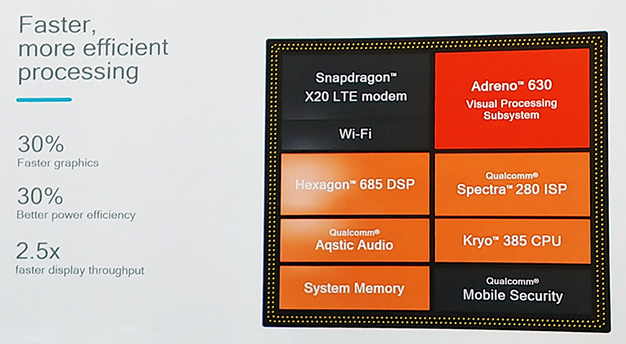Qualcomm Snapdragon 845: Benchmarking A Hot Rod Mobile Chip [Updated]


Qualcomm's new Adreno 630 integrated GPU core is destined to make a big leap in performance over its predecessor as well, with up to a 30 percent increase in graphics throughput, allowing the Snapdragon 845 to become the first mobile platform to enable room-scale VR/AR experiences that support 6 degrees of freedom, along with simultaneous localization and mapping, or SLAM. It should also translate into superior overall gaming performance compared to the Snapdragon 835, which was employed in many of the top flagship Android phones launched during 2017.


Of course, as Qualcomm notes in the slide above, benchmarks don't tell the whole story. It's what smartphone OEMs build with a powerful processing engine and mobile platform, along with the features and functionality they can enable with it. Regardless, we're sure many of you still want to know how this new hot rod chip handles in the turns, so let's get on with it, shall we?
Update - 2/12/2018, 5:00 PM - We are updating a few of our benchmark graphs with scores from the iPhone X and its A11 Bionic processor, as an additional reference point for a flagship Apple device. We don’t have results for every test because not all benchmarks are cross-platform compatible, nor do they present identical workloads across different mobile operating systems. As a result, we're including only those we feel present a level playing field.
|
In our first test, Geekbench, we're stressing only CPU cores in a handset (not graphics), with both single and multi-threaded workloads. The test is comprised of encryption processing, image compression, HTML5 parsing, physics calculations, and other general purpose compute processing.

Next up, we're using the JetStream benchmark for Javascript performance and RightWare’s Web Test 3.0 for comprehensive, mixed-media web performance analysis, including HTML5 rendering. Here we'll primarily determine how the the Snapdragon 845 SoC handles this workload, along with the Android Oreo operating system and Chrome web browser...
|


|
Futuremark's PCMark for Android is an excellent suite of tests that we highly recommend for benchmarking performance of a handset with heavier-duty tasks for things like image and video editing, as well as lighter-duty workloads like email, and web browsing. When you see the test running live it's clear the scripted application tests are carefully selected and tuned to make use of the platforms involved in a very controlled way.

The story is no different with PCMark for Android, as the Snapdragon 845 dominates in photo editing and the Work 2.0 benchmark. We see somewhat of a regression in the Video Editing benchmark compared to the Snapdragon 835, but overall, the numbers so far are looking good for Qualcomm's new chip. Drivers and the OS are likely still being tuned, so it's possible the video editing numbers come back the other way, once retail smartphones ship. Note that the Video Editing test leaders are the highly-tuned Google Pixel 2 and Pixel 2 XL, while the other devices fall behind Snapdragon 845.
Let's get our game on...







